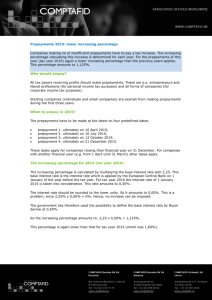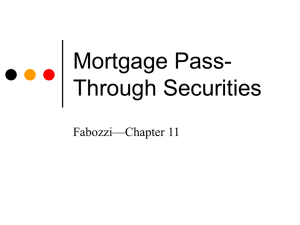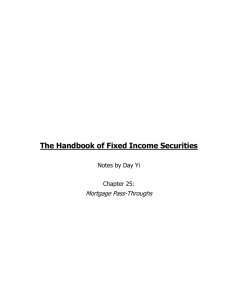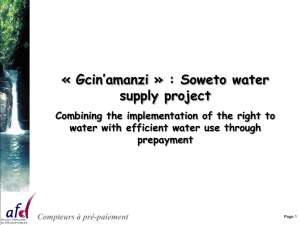A Variable-Rate Loan-Prepayment Model for Australian Mortgages
advertisement
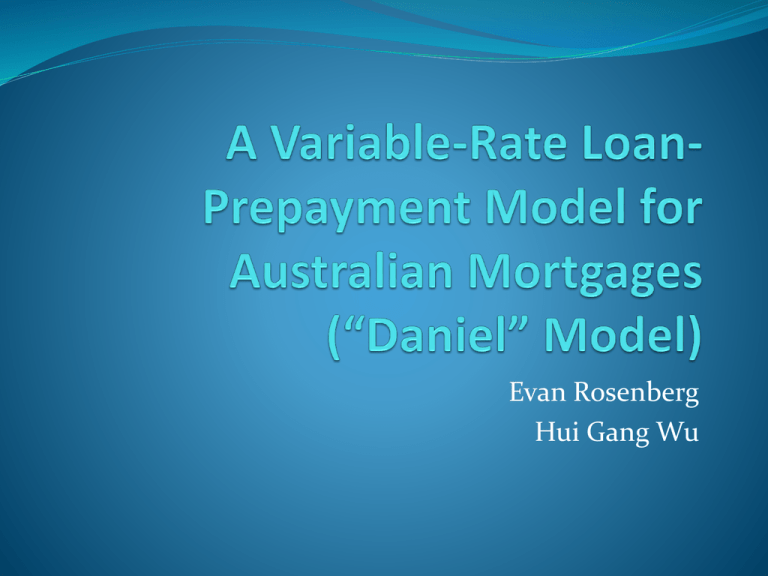
Evan Rosenberg
Hui Gang Wu
I. Objective of This Paper
To investigate Australian mortgage prepayment by
developing and testing prepayment models for loans
in Australian MBSs
II. Method
Daniel used U.S. MBS variable-rate loan prepayment
models (notably McConnell and Singh 1991 and the
related Sanyal 1994 model) as foundations and then
accounted for the differences between the U.S. and
Australian markets
III. Differences between U.S. and
Australian Markets
Tax (in Australia occupying owners cannot deduct their mortgage payments
more incentive to prepay than in U.S.)
Fixed-Rate Loan Term Period (sub-periods in Australia)
Variable-Rate Mortgage Rate (set by lender in competitive mkt in Australia
acts more like a floating rate than in U.S. where rates are tied to indices)
Ratio of FRM and VRM (VRM dominates in Australia – FRM dominates in
U.S.)
Partial Prepayment (uniquely significant in Australia – avg. approx. 1/3 of full
prepayments – often deemed insignificant in U.S.)
Resource/Non-resource Mortgage Loans (lenders in Australia can access
assets beyond the property if borrower defaults)
Subprime/Low Documented Loans (far less in Australia – est. 2% v. 15%)
Caps/Floors (Australian VRMs do not have caps or floors unlike U.S.)
IV. Types of Prepayers And Variables
Relocators: sell their home and move to other places
(maybe due to job change etc.)
Refinancers: refinance to take the advantage of lower
market interest rates
Switchers: change the loan type from FRM to VRM or vice
versa
Partial Prepayers: (ADDED FOR UNIQUE AUSTRALIAN
MODEL) prepay less than the full amount – Daniel
considered potential causes of tax, partial prepayment by
default (maintaining constant payments despite decrease
in rate), and aversion to debt and/or future interest-rate
volatility
A. Relocator Variables
1. AgePool expected to have positive correlation with
Conditional Prepayment Rate (“CPR”)
Weighted Average Seasoning (“WAS”) average age of
the mortgages in the pool, weighted by the value of the
mortgages
MAX{WAS} maximum WAS over all pools
2. Squareroot of AgePool (“SQR(AGEPL)”) expected to
have negative correlation with CPR
3. Seasonal expected to have a positive correlation
with CPR (people tend to move during summer)
B. Refinancer Variables
1. Differential between pool origination coupon rate and
current market rate (“FXDdifl”) expected to have a
positive correlation with CPR (this is a commonly
used variable to express refinancing incentive in U.S.
FRM pools)
(where 3yrFXD=three year fixed mortgage rate)
2. “Burnout” variables:
Fixed-rate mortgagors are differentially sensitive to declines in the rate on
fixed-rate mortgages when making refinancing decisions. The first time that
the market coupon rate on fixed-rate mortgages falls below the coupon rate of an
existing mortgage, e.g., the most sensitive mortgagors in a pool will refinance. That
is, the most rate-sensitive fixed-rate mortgage refinancers will ‘burnout’of the pool.
The second time that the pool is subject to a decline in the current market rate to this
same level, prepayments will be lower than during the first interest-rate cycle. Only if
the current rate on fixed-rate mortgages falls below its previous low will the next level
of rate-sensitive fixed-rate refinancers be induced to refinance their loans.
a. r new min (adopted from U.S. models) expected to
have a positive correlation
b. BURNOUT expected to have a negative correlation
C. Switcher Variables
1. New Long Minimum (“NLM”) each time the fixed
mortgage rate declines to a new minimum, switchers
will tend to prepay to switch to a FRM expected to
have a positive correlation
2. The change in the slope of the yield curve: the relative
change in spread over each month between long- and
short-term interest rates the expected sign of the
coefficient is left as indeterminate.
D. Partial Prepayer Variables
1. Alternative Investment (“ALTINV”) due to non-deductibility of
owner/occupier mortgage interest in Australia there is an
incentive to prepay partial prepayment funds effectively earn
the mortgage rate as an after-tax interest rate (alternative
investments are only attractive if the after-tax return exceeds the
mortgage rate) expected to have a positive correlation
RAOA = the average continuous compounded return on the All
Ordinaries Accumulation Index (over the previous twelve
months)
SVR = an acronym for ‘standard variable rate’, the standard
variable-rate in Australia, calculated, (by the RBA), by averaging
the variable-rates of Australian commercial lenders.
2. Default Partial Prepayment (“ParDFLT”)
prepayment by default where a borrower optionally
maintains payment levels even as the rate and amount
due declines (common in Australia where banks
encourage borrowers to maintain payment levels and
often “directly debit” borrowers’ accounts) expected
to have a positive correlation
3. Rate Volatility aversion to debt may lead borrowers
to partially prepay in response to increasing rate
volatility expected to have a positive correlation
V. Empirical Evaluation of the
Australian Variable-Rate Model
After using statistical methods to examine the
aforementioned variables, some variables are
eliminated. Finally, the following formulas can be
defined for CPR Partial, CPR Full, and CPR total.
VI. Findings
a) most noteworthy result of empirical tests is
how well the restricted model performed
compared to the unrestricted model
unrestricted model
CPR = f(AGEPOOL,SQR(AGEPL),ParDFLT,ALTINV,FXDdifl,
BURNOUT,VOLy, SLYC,NLM,SEASONAL,rNewMin)
restricted model
CPR = f(AGEPOOL,SQR(AGEPL),ParDFLT)
VI. Findings (cont.)
b) the ParDFLT1 variable is highly significant as a predictor
for full prepayments and partial prepayments, whereas it
was intended as a predictor for partial prepayments only
ParDFLT is a measure of the differential rate between rates of a
(variable-rate) borrower repaying by direct debit and the current
market variable-rate. Daniel had assumed that there was not a
significant enough difference between competing lenders’
variable-rates to induce VRM-to-VRM refinancing “In review
the possibility that some variable-rate borrowers find
refinancing to another more competitive variable-rate loan
clearly cannot be excluded” (same for switch to FRM) thus,
the way the ParDFLT variable is calculated results in the
capture of partial prepayers, refinancers, and perhaps
switchers
VI. Findings (cont.)
c) the age of the pool is a strong influence on full prepayment.
(Age means the average number of months since origination of the
mortgages in the pool).
d) FXDdifl, VOLy1, and SLYC were univariately significant and correct
sign interest-rate variables for full prepayments of VRM holders
(though not significant as variables for the best model multivariate
tests)
e) the prepayment data revealed that in Australia partial prepayment is
on average approximately one third of full prepayments for variablerate loans.
f) the independent variables explain full prepayment much more
effectively than partial prepayment.
g) the new Australian prepayment model proved successful when
tested on (Reuters) Australian MBS data; parsimonious forms of
the model were able to successfully explain both total
prepayment and the components of total prepayment: full and
partial prepayment.


